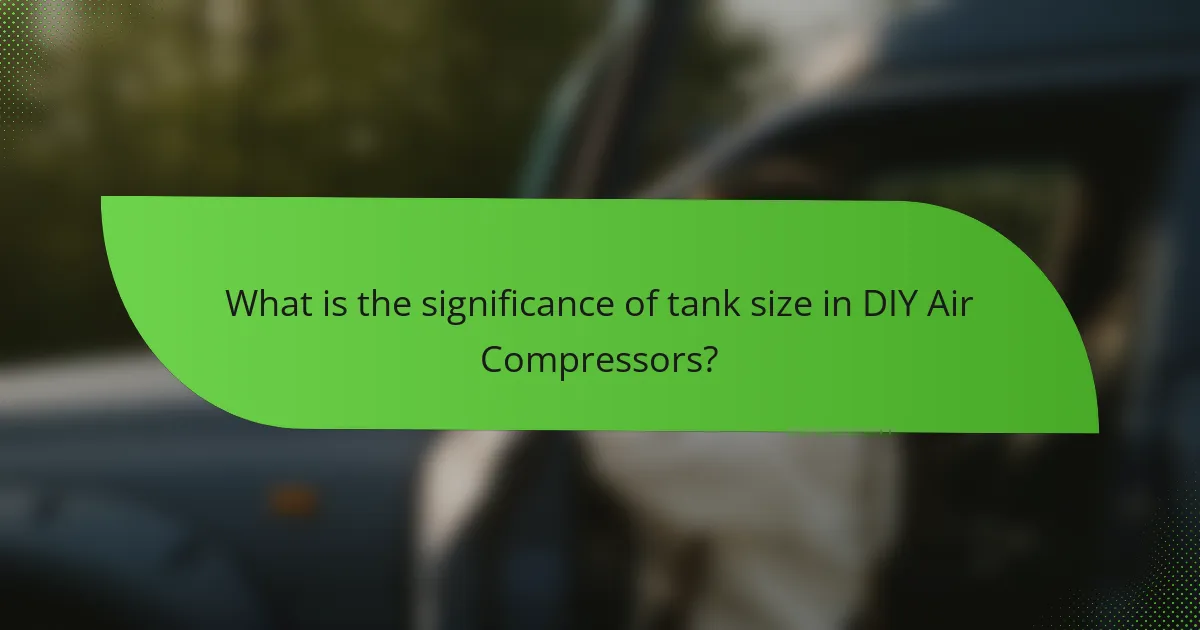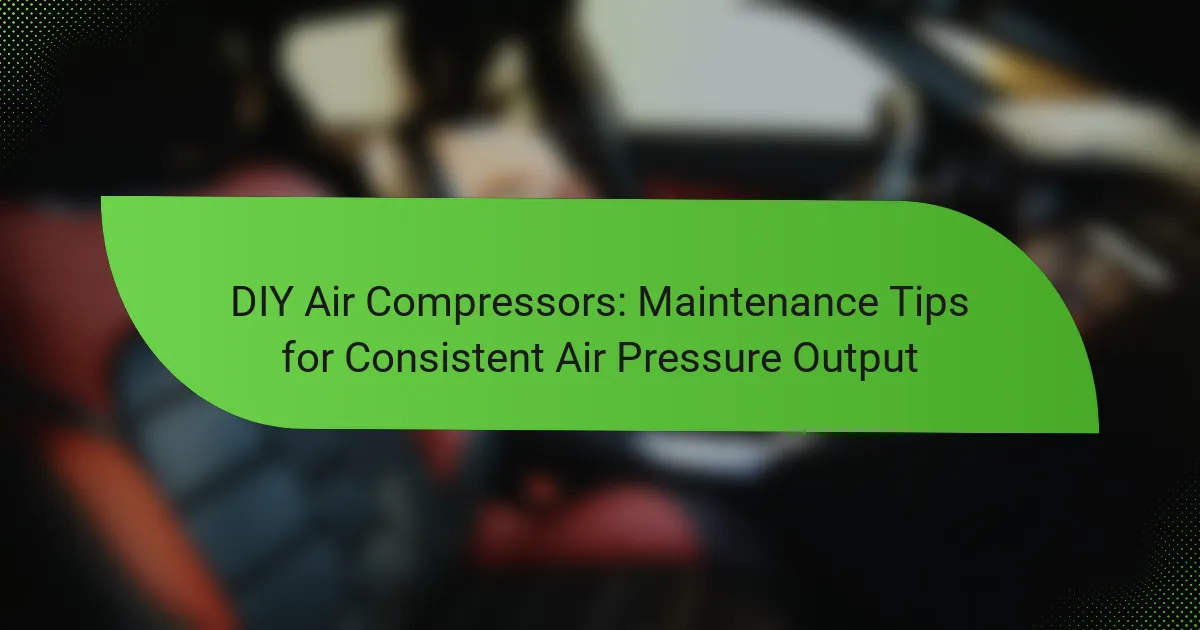DIY air compressors are devices that convert electrical power into potential energy stored in pressurized air, essential for tasks such as inflating tires and powering pneumatic tools. The article explores the significance of tank size in DIY air compressors, emphasizing how it affects air storage capacity and pressure output. A larger tank allows for longer usage times and consistent air pressure, while a smaller tank may lead to quicker depletion and reduced tool efficiency. Key considerations for selecting tank size include intended use, required air volume and pressure for specific tools, available space, and compressor recovery time. Understanding these factors is crucial for optimizing performance and minimizing energy waste in DIY air compressor systems.

What are DIY Air Compressors and Why are They Important?
DIY air compressors are devices that convert power into potential energy stored in pressurized air. They are essential for various tasks such as inflating tires, powering pneumatic tools, and performing spray painting. DIY air compressors allow individuals to create their own systems tailored to specific needs. This customization can lead to cost savings and enhanced efficiency. According to the U.S. Department of Energy, compressed air is one of the most expensive forms of energy, making efficiency crucial. Properly designed DIY air compressors can minimize energy waste and optimize performance. Their importance lies in their versatility and ability to empower users in home improvement projects and maintenance tasks.
How do DIY Air Compressors function in various applications?
DIY air compressors function by converting power into potential energy stored in pressurized air. This process typically involves an electric motor that drives a piston or a rotary screw compressor. As the motor operates, it compresses air into a storage tank, increasing the air pressure. The compressed air can then be released for various applications.
In automotive work, DIY air compressors power tools like impact wrenches and tire inflators. In construction, they operate nail guns and paint sprayers. For home use, they can inflate sports equipment and air mattresses. The efficiency of these applications often depends on the tank size, which affects the volume of air available and the duration of tool operation. Larger tanks can store more compressed air, allowing for longer use without needing to refill.
Research indicates that a tank size of 20 gallons can provide sufficient pressure for most household tasks. This makes DIY air compressors versatile tools for both hobbyists and professionals.
What are the key components of a DIY Air Compressor?
The key components of a DIY air compressor include a motor, a pump, a tank, a regulator, and fittings. The motor powers the pump, which compresses the air. The tank stores the compressed air for later use. The regulator controls the pressure of the air being released. Fittings connect various parts of the compressor system. Each component plays a crucial role in the overall functionality. A well-assembled DIY air compressor can effectively provide the necessary air pressure for various tasks.
How does air compression work in DIY projects?
Air compression in DIY projects involves the use of a compressor to increase air pressure. The compressor draws in ambient air and reduces its volume, which raises the pressure. This pressurized air is then stored in a tank for later use.
In DIY applications, compressed air powers tools like nail guns and spray painters. The effectiveness of these tools depends on the pressure and volume of the compressed air. A larger tank allows for more air storage, which can maintain consistent pressure during use.
For example, a tank with a capacity of 6 gallons can deliver air pressure suitable for most home projects. Understanding the relationship between tank size and air pressure output is crucial for efficient operation in DIY tasks.
What factors influence the performance of a DIY Air Compressor?
The performance of a DIY air compressor is influenced by several key factors. These include tank size, motor power, and pump efficiency. Tank size determines the volume of compressed air available for use. A larger tank can store more air, leading to longer usage times without needing to refill. Motor power affects the compressor’s ability to refill the tank quickly. A more powerful motor can compress air faster, improving overall efficiency. Pump efficiency refers to how effectively the compressor converts electrical energy into compressed air. Higher efficiency results in less energy waste and better performance. Additionally, the type of compressor design, such as piston or diaphragm, impacts performance characteristics. Each design has its own strengths and weaknesses in terms of air delivery and pressure maintenance.
How does tank size impact air pressure output?
Tank size directly impacts air pressure output in air compressors. Larger tanks can store more compressed air, which allows for a higher volume of air to be delivered at a consistent pressure. This is crucial for applications requiring sustained air flow. Conversely, smaller tanks may deplete air pressure more quickly during use. The pressure output is also influenced by the compressor’s ability to replenish air in the tank. A tank that is too small may not keep up with demand, leading to fluctuations in pressure. Therefore, selecting the appropriate tank size is essential for maintaining stable air pressure during operation.
What is the relationship between tank size and air delivery rate?
Tank size directly influences the air delivery rate of an air compressor. A larger tank can store more compressed air. This allows for a higher air delivery rate over a longer period. Conversely, a smaller tank may deplete faster. This results in a lower air delivery rate, especially during continuous use. The air delivery rate is measured in cubic feet per minute (CFM). A typical 20-gallon tank can deliver around 5-6 CFM. In contrast, a 5-gallon tank may only deliver 2-3 CFM. Therefore, tank size is crucial for applications requiring sustained air pressure.

What is the significance of tank size in DIY Air Compressors?
Tank size in DIY air compressors is significant because it directly affects air storage capacity and pressure output. A larger tank can hold more compressed air, leading to longer usage times without the need for frequent cycling. This allows for consistent air pressure during operations, which is crucial for tools that require steady airflow. Conversely, a smaller tank may lead to quicker depletion of air, causing tools to lose power or efficiency. For example, a 20-gallon tank can provide air for extended periods compared to a 5-gallon tank, which may need to refill more often. Thus, the tank size plays a critical role in determining the performance and efficiency of DIY air compressors.
How does tank size affect the efficiency of air compression?
Tank size significantly affects the efficiency of air compression. A larger tank allows for more air storage, which reduces the frequency of the compressor cycling on and off. This results in more consistent pressure and less energy wasted during startup. Additionally, larger tanks can maintain a more stable pressure over extended periods. According to the U.S. Department of Energy, compressors with larger tanks operate more efficiently, as they can draw air less often, leading to reduced wear and tear. Therefore, selecting an appropriate tank size is crucial for optimizing air compression efficiency.
What are the benefits of larger vs. smaller tanks?
Larger tanks provide increased air storage capacity, allowing for longer usage between refills. This results in more consistent air pressure during operation. Larger tanks can also accommodate higher volume tools and applications. In contrast, smaller tanks are more portable and easier to store. They heat up more quickly and can be used for lighter tasks. Smaller tanks typically have faster recovery times, making them suitable for quick jobs. According to a study by the American Society of Mechanical Engineers, larger tanks can sustain pressure better during prolonged use. This highlights the benefits of choosing the appropriate tank size based on specific project needs.
How does tank size influence the duration of air supply?
Tank size directly influences the duration of air supply. Larger tanks store more compressed air, allowing for longer usage before needing to refill. For instance, a 20-gallon tank can provide air for a longer duration compared to a 5-gallon tank. This is due to the increased volume of air available for consumption. Additionally, the air pressure in the tank remains more stable in larger tanks, which can enhance the efficiency of air tools. Studies show that air tools operate optimally with consistent pressure, which larger tanks can better maintain. Therefore, the size of the tank is crucial for determining how long air supply lasts during operation.
What are the common misconceptions about tank size in air compressors?
One common misconception about tank size in air compressors is that a larger tank always means more air pressure. In reality, tank size primarily affects the volume of air stored, not the pressure itself. Air compressors generate pressure based on their pump capacity, not tank size. Another misconception is that a larger tank is necessary for all applications. Smaller tanks can be sufficient for tasks that require less continuous airflow. Additionally, some believe that a larger tank reduces the frequency of compressor cycling. While larger tanks may extend run times, they do not eliminate cycling. Understanding these misconceptions helps users select the right compressor for their needs.
Why do some people underestimate the importance of tank size?
Some people underestimate the importance of tank size in air compressors due to a lack of understanding of its impact on performance. A smaller tank can lead to more frequent cycling of the compressor, which reduces efficiency. Users may assume that a smaller tank is sufficient for short tasks without realizing it limits air supply. This misconception can result in inadequate pressure for tools, causing frustration during use. Additionally, many beginners focus on horsepower or PSI ratings instead of tank capacity. Educational resources often emphasize other features, leaving tank size overlooked. Understanding the relationship between tank size and air delivery is crucial for optimal performance in DIY projects.
How can incorrect tank size selection affect project outcomes?
Incorrect tank size selection can lead to inefficiencies in project outcomes. A tank that is too small may not provide sufficient air supply, causing the compressor to run continuously. This can lead to overheating and increased wear on the compressor. Conversely, a tank that is too large can result in longer recovery times and wasted energy. Inaccurate size selection can also affect the pressure consistency required for specific tasks. A study by the American Society of Mechanical Engineers indicates that optimal tank sizing can enhance operational efficiency by up to 30%. Thus, choosing the correct tank size is crucial for maximizing performance and minimizing operational costs.

What practical considerations should be made when selecting a tank size?
When selecting a tank size for a DIY air compressor, consider the intended use. The tank size impacts air pressure output and duration of use. Larger tanks store more air, allowing for longer operation without frequent cycling. Smaller tanks are more portable but may require more frequent refilling. Assess the tools and equipment to be powered. Different tools require varying air volumes and pressures. For example, spray guns may need larger tanks compared to inflators. Additionally, evaluate the available space for the compressor. Space constraints may limit tank size options. Finally, consider the compressor’s recovery time. A larger tank may reduce the frequency of the compressor running, leading to less wear.
How do you determine the ideal tank size for your needs?
To determine the ideal tank size for your needs, assess your specific air consumption requirements. Identify the tools or equipment you plan to use with the air compressor. Calculate the average cubic feet per minute (CFM) needed for those tools. Consider the duration of use; longer tasks may require a larger tank. Evaluate the frequency of tool usage; intermittent use allows for smaller tanks. Assess the pressure requirements of your tools, as higher pressure needs may necessitate a larger tank. A general guideline is that a tank size of 4 to 6 gallons suits most home projects. For industrial applications, larger tanks of 20 gallons or more may be necessary.
What factors should you consider when choosing tank size?
When choosing tank size for DIY air compressors, consider the air demand of your tools. Larger tools typically require more air volume and pressure. The tank size should match the cumulative air consumption of all tools used simultaneously. A 6-gallon tank may suffice for small tools, while larger tools may require tanks of 20 gallons or more. Additionally, consider the frequency of use; larger tanks can sustain longer operation without frequent cycling. Lastly, evaluate available space; larger tanks need more physical space. These factors ensure optimal performance and efficiency in air pressure output.
How can you balance tank size with portability and storage?
To balance tank size with portability and storage, select a tank that meets your air demand without excessive bulk. A smaller tank, typically 1 to 6 gallons, offers better portability for light tasks. Larger tanks, over 6 gallons, provide more air but can be cumbersome. Consider the weight of the tank; lighter tanks enhance mobility. Additionally, look for designs that allow for easy storage, such as vertical tanks. Evaluate the intended use; frequent transport may necessitate a smaller size. Always assess your air requirements to find the optimal tank size that maintains efficiency while being manageable.
What tips can help optimize the performance of your DIY Air Compressor?
To optimize the performance of your DIY air compressor, ensure proper tank size relative to pressure needs. A larger tank can store more air, providing consistent pressure for tools. Regularly check for leaks in hoses and connections, as leaks reduce efficiency. Use high-quality filters to keep moisture and debris out of the system. Maintain the compressor by changing oil and cleaning air filters as needed. Ensure the compressor is placed in a well-ventilated area to prevent overheating. Finally, match the compressor’s output to the requirements of your tools for efficient operation.
How can regular maintenance improve tank performance?
Regular maintenance can significantly improve tank performance. It ensures optimal air pressure levels in the tank. Routine checks can identify leaks, which can otherwise lead to pressure loss. Maintenance also includes draining moisture that accumulates in the tank. Moisture can cause rust and corrosion, affecting tank integrity. Regularly checking and replacing filters improves air quality and efficiency. Efficient airflow results in better pressure output. Studies show that well-maintained tanks can operate up to 20% more efficiently.
What are the best practices for using tank size effectively in projects?
Select the appropriate tank size based on the project’s air demand. A larger tank can store more compressed air, reducing the frequency of compressor cycling. Analyze the tools and equipment that will be used. Calculate their cumulative air consumption rates to determine the necessary tank volume. Use a tank that allows for a buffer in air supply. This prevents interruptions during high-demand tasks. Ensure the tank is rated for the required pressure levels. This guarantees safety and efficiency during operation. Regularly maintain the tank to prevent corrosion and leaks. Proper maintenance extends the tank’s lifespan and ensures optimal performance.
DIY air compressors are devices that convert power into potential energy stored in pressurized air, crucial for tasks such as inflating tires and powering tools. This article explores the significance of tank size in DIY air compressors, detailing how it impacts air pressure output, efficiency, and the duration of air supply. Key factors influencing performance, including motor power and pump efficiency, are discussed alongside common misconceptions about tank size. Practical considerations for selecting the appropriate tank size based on specific project needs and tools are also outlined to optimize compressor performance.



